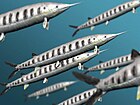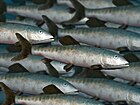
The Bayan Shireh Formation is a geological formation in Mongolia, that dates to the Cretaceous period. It was first described and established by Vasiliev et al. 1959.
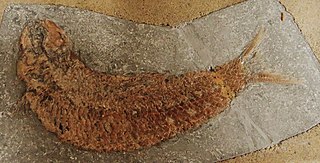
Pholidophorus is an extinct genus of stem-teleost fish. Numerous species were assigned to this genus in the past, but only the type species Pholidophorus latiusculus, from the Late Triassic of Europe, is considered to be a valid member of the genus today.
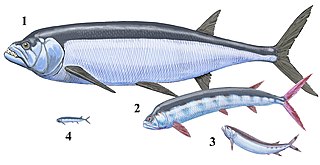
Ichthyodectiformes is an extinct order of marine stem-teleost ray-finned fish. The order is named after the genus Ichthyodectes, established by Edward Drinker Cope in 1870. Ichthyodectiforms are usually considered to be some of the closest relatives of the teleost crown group.

Pachycormiformes is an extinct order of marine ray-finned fish known from the Early Jurassic to the end of the Cretaceous. It only includes a single family, Pachycormidae. They were characterized by having serrated pectoral fins, reduced pelvic fins and a bony rostrum. Pachycormiformes are morphologically diverse, containing both tuna and swordfish-like carnivorous forms, as well as edentulous suspension-feeding forms.
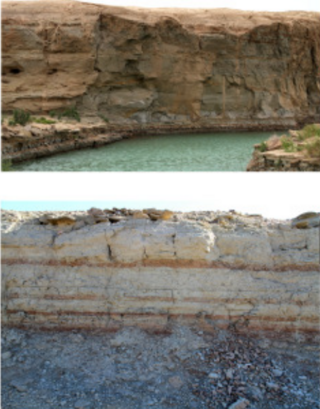
The Tugulu Group is a geological Group in Xinjiang, China whose strata date back to the Early Cretaceous. Dinosaur skeletal remains and footprints are among the fossils that have been recovered from the formation.

Araripichthys is an extinct genus of marine ray-finned fish that lived from the Aptian to Coniacian stages of the Cretaceous period. The genus is named after the Araripe Basin, where it was found in the Crato and Santana Formations. Other fossils of the genus have been found at Goulmima in Morocco, the Tlayua Formation of Mexico and the Apón Formation of Venezuela.
The Intertrappean Beds are a Late Cretaceous and Early Paleocene geologic formation in India. The beds are found as interbeds between Deccan Traps layers, including the slightly older Lameta Formation. The formation spans the Cretaceous–Paleogene boundary, with a stratigraphic range of only a few hundred thousand years before and after the boundary, and a significant debate exists about whether specific sites belong to the Cretaceous or the Paleocene.

Bonnerichthys is a genus of fossil fishes within the family Pachycormidae that lived during the Coniacian to Maastrichtian stage of the Late Cretaceous. Fossil remains of this taxon were first described from the Smoky Hill Member of the Niobrara Chalk Formation of Kansas, and additional material was later reported from the Pierre Shale, Mooreville Chalk, Demopolis Chalk, Wenonah Formation, and Moreno Formation, among other localities. It grew to at least 5 metres (16 ft) in total body length, substantially less than the related Leedsichthys from the Jurassic which likely grew up to 16.5 metres (54 ft).
Paleontology or palaeontology is the study of prehistoric life forms on Earth through the examination of plant and animal fossils. This includes the study of body fossils, tracks (ichnites), burrows, cast-off parts, fossilised feces (coprolites), palynomorphs and chemical residues. Because humans have encountered fossils for millennia, paleontology has a long history both before and after becoming formalized as a science. This article records significant discoveries and events related to paleontology that occurred or were published in the year 2011.

Paleontology or palaeontology is the study of prehistoric life forms on Earth through the examination of plant and animal fossils. This includes the study of body fossils, tracks (ichnites), burrows, cast-off parts, fossilised feces (coprolites), palynomorphs and chemical residues. Because humans have encountered fossils for millennia, paleontology has a long history both before and after becoming formalized as a science. This article records significant discoveries and events related to paleontology that occurred or were published in the year 2013.

Egg fossils are the fossilized remains of eggs laid by ancient animals. As evidence of the physiological processes of an animal, egg fossils are considered a type of trace fossil. Under rare circumstances a fossil egg may preserve the remains of the once-developing embryo inside, in which case it also contains body fossils. A wide variety of different animal groups laid eggs that are now preserved in the fossil record beginning in the Paleozoic. Examples include invertebrates like ammonoids as well as vertebrates like fishes, possible amphibians, and reptiles. The latter group includes the many dinosaur eggs that have been recovered from Mesozoic strata. Since the organism responsible for laying any given egg fossil is frequently unknown, scientists classify eggs using a parallel system of taxonomy separate from but modeled after the Linnaean system. This "parataxonomy" is called veterovata.
This list of fossil fish species is a list of taxa of fish that have been described during the year 2012. The list only includes taxa at the level of genus or species.
This list of fossil fishes described in 2013 is a list of new taxa of placoderms, fossil cartilaginous fishes and bony fishess of every kind that have been described during the year 2013. The list only includes taxa at the level of genus or species.
This list of fossil fishes described in 2015 is a list of new taxa of jawless vertebrates, placoderms, acanthodians, fossil cartilaginous fishes, bony fishes and other fishes of every kind that have been described during the year 2015, as well as other significant discoveries and events related to paleontology of fishes that occurred in the year 2015. The list only includes taxa at the level of genus or species.
This list of fossil fish research presented in 2021 is a list of new taxa of jawless vertebrates, placoderms, acanthodians, fossil cartilaginous fishes, bony fishes, and other fishes that were described during the year, as well as other significant discoveries and events related to paleoichthyology that occurred in 2021.
This list of fossil fish research presented in 2022 is a list of new taxa of jawless vertebrates, placoderms, acanthodians, fossil cartilaginous fishes, bony fishes, and other fishes that were described during the year, as well as other significant discoveries and events related to paleoichthyology that occurred in 2022.

Pholidophoridae is an extinct family of primitive stem-teleost fish that lived during the Triassic period, from the Anisian age of the Middle Triassic to the Norian age of the Late Triassic. Most of the genera are from Europe, but one (Malingichthys) is known from China. The pholidophorids were historically united with several other stem-teleost lineages into the order Pholidophoriformes, but Pholidophoriformes in its traditional sense is now considered paraphyletic with respect to crown group teleosts.
This list of fossil fish research presented in 2023 is a list of new taxa of jawless vertebrates, placoderms, acanthodians, fossil cartilaginous fishes, bony fishes, and other fishes that were described during the year, as well as other significant discoveries and events related to paleoichthyology that occurred in 2023.











